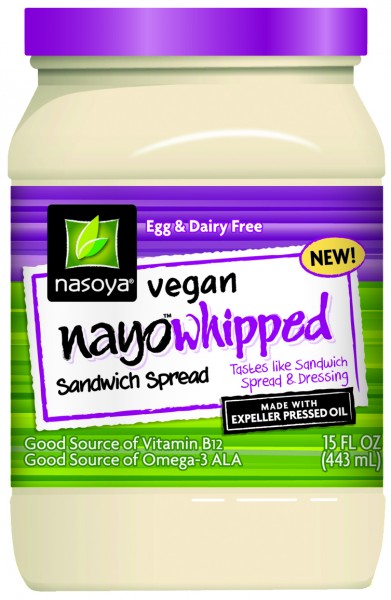
Recently, the kind folks at
Nasoya–whose tofu I purchase frequently–generously sent me samples of their newly reformulated
Nayonaise and
Nayonaise–Whipped vegan mayo/sandwich spread.
I refrigerated it for a couple of days so that I could conduct a taste test, enjoying it as I would actually eat it. During that test, because I wasn’t mixing it with other food, I took TINY tastes, but I took quite a few in order to accurately compare these products to my standard Grapeseed Vegenaise. (Note: when I reference Vegenaise below, it is the Grapeseed variety.)
If, as a cookbook author (The Blooming Platter: A Harvest of Seasonal Vegan Recipes, 2011), I have learned anything, it is that people’s palates are as different as the people themselves. So, I would be very hesitant to suggest that one product tastes “better” than another. Rather, I prefer to share what I perceive as differences, and encourage you to taste and decide on a preference for yourself. Plus, I think where one was brought up has more than a little to do with one’s preference!
All three products have a list of benefits as long as your arm! So, please visit the Nasoya website for complete nutrition information on Nayonaise as well as recipes. One benefit on the Nayonaise scorecard worth mentioning here is that it contains 10% of the recommended daily allowance of B-12 and is a good source of Omega-3 ALA.
 But, in general, I focused on color, taste and texture in my informal test. However, those of you counting calories might appreciate knowing that Nayonaise has less than half as many calories as Vegenaise: 40 vs. 90 per tablespoon.
But, in general, I focused on color, taste and texture in my informal test. However, those of you counting calories might appreciate knowing that Nayonaise has less than half as many calories as Vegenaise: 40 vs. 90 per tablespoon.
In terms of color, Vegenaise is the whitest. So if pure color is important to your recipe, I would recommend it. Both Nayonaise varieties have a pale warmth to their color, with the Whipped version having the most. This is likely due to the inclusion of turmeric, paprika and garlic powder in the ingredients of both Nayonaise products.
In terms of taste, I found Vegenaise to be the most neutral. Again, the turmeric, paprika and garlic powder no doubt give the Nayonaise a more distinctive flavor. Distinctive is not necessarily better–or worse– just a little more pronounced, so I would make a decision based on how I planned to use it.
To my palate, Vegenaise has decidedly tangy-salty notes (though the lowest amount of sodium), while I found tanginess with just a hint of sweetness to be the most pronounced characteristic of Nayonaise and tangy-sweetness to be the most pronounced of Nayonaise–Whipped (which has just 5 more mg. of sodium than Vegenaise). The differences in “tang” can no doubt be explained, in part, by the fact that apple cider vinegar (a fairly mild vinegar, as vinegars go) is the 4th ingredient listed on the Vegenaise label, while plain vinegar is the third ingredient listed on the Nayonaise labels.
It has been many years since I tasted non-vegan mayo but, based on my best recollection, I would suggest that Vegenaise perhaps has more in common with Hellman’s mayonnaise while Nayonaise with a sandwich spread like Miracle Whip. I always felt that Miracle Whip tasted like it contained pickle relish, and I detected the same hints from, especially, the Nayonaise–Whipped. I love pickle relish, but not necessarily in every recipe that calls for mayonnaise, so I would choose accordingly.
And, finally, in terms of texture, while all were creamy, I would say that Vegenaise is fluffier than Nayonaise, including the Whipped variety, which I didn’t find appreciably different in texture than the non-whipped. Nayonaise contains Xanthan Gum and Guar Gum which probably accounts for what I can only describe as a consistency similar to a condensed canned soup before it is heated, a texture I didn’t perceive in Vegenaise.
So, that’s it: the results of my quickie taste test. Thanks, again, to Nasoya for sharing their new take on Nayonaise with me so that I could share it with you. We now have two new options for slathering on our fresh tomato sandwiches this summer!








 This is about the most festive–and tastiest, not to mention easiest–candy going!
This is about the most festive–and tastiest, not to mention easiest–candy going!  If you don’t have time to read this review, I’ll cut to the chase: I would certainly purchase for myself or as a gift
If you don’t have time to read this review, I’ll cut to the chase: I would certainly purchase for myself or as a gift 

